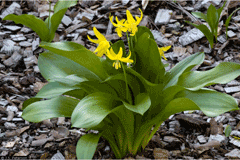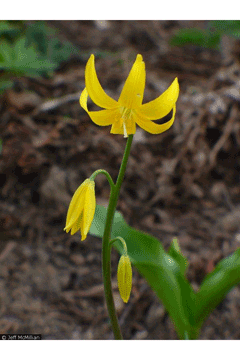 |
|
J.S. Peterson @ USDA-NRCS PLANTS Database |
 |
| Jeff McMillian @ USDA-NRCS PLANTS Database |
Translate this page:
Summary
Bloom Color: Yellow. Main Bloom Time: Early spring, Mid spring. Form: Irregular or sprawling.
Physical Characteristics

 Erythronium tuolumnense is a BULB growing to 0.3 m (1ft) by 0.2 m (0ft 8in) at a medium rate.
Erythronium tuolumnense is a BULB growing to 0.3 m (1ft) by 0.2 m (0ft 8in) at a medium rate.
It is not frost tender. It is in flower from April to May, and the seeds ripen from June to July. The species is hermaphrodite (has both male and female organs).
Suitable for: light (sandy) and medium (loamy) soils and prefers well-drained soil. Suitable pH: mildly acid, neutral and basic (mildly alkaline) soils. It can grow in semi-shade (light woodland). It prefers moist soil.
UK Hardiness Map
US Hardiness Map
Synonyms
Plant Habitats
Woodland Garden Dappled Shade; Shady Edge;
Edible Uses
Edible Parts: Root
Edible Uses:
Although no specific mention has been found for this species, most if not all members of the genus provide edible bulbs[K]. The ovoid bulb is 5 - 10cm long[270].
References More on Edible Uses
Medicinal Uses
Plants For A Future can not take any responsibility for any adverse effects from the use of plants. Always seek advice from a professional before using a plant medicinally.
None known
References More on Medicinal Uses
The Bookshop: Edible Plant Books
Our Latest books on Perennial Plants For Food Forests and Permaculture Gardens in paperback or digital formats.

Edible Tropical Plants
Food Forest Plants for Hotter Conditions: 250+ Plants For Tropical Food Forests & Permaculture Gardens.
More

Edible Temperate Plants
Plants for Your Food Forest: 500 Plants for Temperate Food Forests & Permaculture Gardens.
More

More Books
PFAF have eight books available in paperback and digital formats. Browse the shop for more information.
Shop Now
Other Uses
References More on Other Uses
Cultivation details
Landscape Uses:Alpine garden, Container, Rock garden, Woodland garden. Prefers slightly acid soil conditions but succeeds in chalky soils if these contain plenty of humus[164]. Requires semi-shade, preferably provided by trees or shrubs, and a well-drained soil[42, 164]. Succeeds in almost any light soil, preferring one that is rich in humus[1]. Plants are hardy to at least -15°c[200]. Plants are spreading well, but only flowering lightly in the dappled shade of a woodland garden at Kew[K]. Bulbs should be planted about 7cm deep[1]. They increase rapidly by offsets[188]. Special Features:
Attractive foliage, North American native, Naturalizing.
References Carbon Farming Information and Carbon Sequestration Information
Temperature Converter
Type a value in the Celsius field to convert the value to Fahrenheit:
Fahrenheit:
The PFAF Bookshop
Plants For A Future have a number of books available in paperback and digital form. Book titles include Edible Plants, Edible Perennials, Edible Trees,Edible Shrubs, Woodland Gardening, and Temperate Food Forest Plants. Our new book is Food Forest Plants For Hotter Conditions (Tropical and Sub-Tropical).
Shop Now
Plant Propagation
Seed - best sown as soon as it is ripe in a shady position in a cold frame. Water lightly in summer, it should germinate in autumn or winter[164, 200]. Stored seed requires a period of cold stratification[164]. Sow as early in spring as possible in a cold frame. Sow the seed thinly so that it will not be necessary to prick them out for their first year of growth. Give an occasional liquid feed to the seedlings to make sure that they do not become nutrient deficient. When the plants are dormant, pot up the small bulbs putting 2 - 3 bulbs in each pot. Grow them on in a shady position in the greenhouse for another 2 3 years and then plant them out into their permanent positions when they are dormant in late summer. Division of the bulbs in the summer as the leaves die down[1]. Larger bulbs can be replanted immediately into their permanent positions, but it is best to pot up smaller bulbs and grow them on in a shady position in a greenhouse for a year before planting them out when dormant in late summer.
Other Names
If available other names are mentioned here
Native Range
NORTHERN AMERICA: United States (California (east-central))
Weed Potential
Right plant wrong place. We are currently updating this section.
Please note that a plant may be invasive in one area but may not in your area so it's worth checking.
Conservation Status
IUCN Red List of Threatened Plants Status :

| Related Plants
|
| Latin Name | Common Name | Habit | Height | Hardiness | Growth | Soil | Shade | Moisture | Edible | Medicinal | Other |
| Erythronium albidum | White Trout-Lily, White fawnlily | Bulb | 0.1 |
4-8
| | LM | S | M | 3 | 0 | |
| Erythronium albidum mesochoreum | Prairie Trout Lily | Bulb | 0.1 |
4-8
| | LM | S | M | 3 | 0 | |
| Erythronium americanum | Trout Lily, Dogtooth violet | Bulb | 0.2 |
3-7
| | LM | S | M | 4 | 1 | 3 |
| Erythronium californicum | Fawn Lily, California fawnlily | Bulb | 0.3 |
0-0
| | LM | S | M | 2 | 0 | |
| Erythronium citrinum | Pale Fawn Lily, Cream fawnlily, Roderick's fawnlily | Bulb | 0.3 |
0-0
| | LM | S | M | 2 | 0 | |
| Erythronium dens-canis | Dog's-Tooth Violet | Bulb | 0.2 |
3-7
| | LM | S | M | 3 | 0 | |
| Erythronium grandiflorum | Avalanche Lily, Yellow avalanche-lily | Bulb | 0.2 |
4-8
| | LM | S | DM | 3 | 1 | |
| Erythronium helenae | Mt. St. Helena Fawm Lily, Pacific fawnlily | Bulb | 0.3 |
4-8
| | LM | S | M | 2 | 0 | |
| Erythronium hendersonii | Henderson's Fawn Lily | Bulb | 0.3 |
0-0
| | LM | S | M | 2 | 0 | |
| Erythronium howellii | Howell's Fawn Lily | Bulb | 0.3 |
-
| | LM | S | M | 2 | 0 | |
| Erythronium japonicum | Katakuri | Bulb | 0.2 |
-
| | LM | S | M | 4 | 0 | |
| Erythronium montanum | Avelanche Lily, White avalanche-lily | Bulb | 0.3 |
0-0
| | LM | S | M | 2 | 0 | |
| Erythronium multiscapideum | Adderstongue | Bulb | 0.3 |
-
| | LM | S | M | 2 | 0 | |
| Erythronium oregonum | Giant White Fawnlily | Bulb | 0.5 |
4-8
| | LM | S | M | 2 | 1 | |
| Erythronium purpurascens | Avelanche Lily, Purple fawnlily | Bulb | 0.3 |
0-0
| | LM | S | M | 2 | 0 | |
| Erythronium revolutum | Pink Fawn Lily, Mahogany fawnlily | Bulb | 0.3 |
4-8
| | LM | S | M | 3 | 0 | |
|
Growth: S = slow M = medium F = fast. Soil: L = light (sandy) M = medium H = heavy (clay). pH: A = acid N = neutral B = basic (alkaline). Shade: F = full shade S = semi-shade N = no shade. Moisture: D = dry M = Moist We = wet Wa = water.
Now available:
Food Forest Plants for Mediterranean Conditions
350+ Perennial Plants For Mediterranean and Drier Food Forests and Permaculture Gardens.
[Paperback and eBook]
This is the third in Plants For A Future's series of plant guides for food forests tailored to
specific climate zones. Following volumes on temperate and tropical ecosystems, this book focuses
on species suited to Mediterranean conditions—regions with hot, dry summers and cool, wet winters,
often facing the added challenge of climate change.
Read More
Expert comment
Author
Applegate.
Botanical References
200270
Links / References
For a list of references used on this page please go here
Readers comment
| Add a comment |
|
If you have important information about this plant that may help other users please add a comment or link below. Only comments or links that are felt to be directly relevant to a plant will be included. If you think a comment/link or information contained on this page is inaccurate or misleading we would welcome your feedback at [email protected]. If you have questions about a plant please use the Forum on this website as we do not have the resources to answer questions ourselves.
* Please note: the comments by website users are not necessarily those held by PFAF and may give misleading or inaccurate information.
To leave a comment please Register or login here All comments need to be approved so will not appear immediately.
|
Subject : Erythronium tuolumnense
|
|
|
|